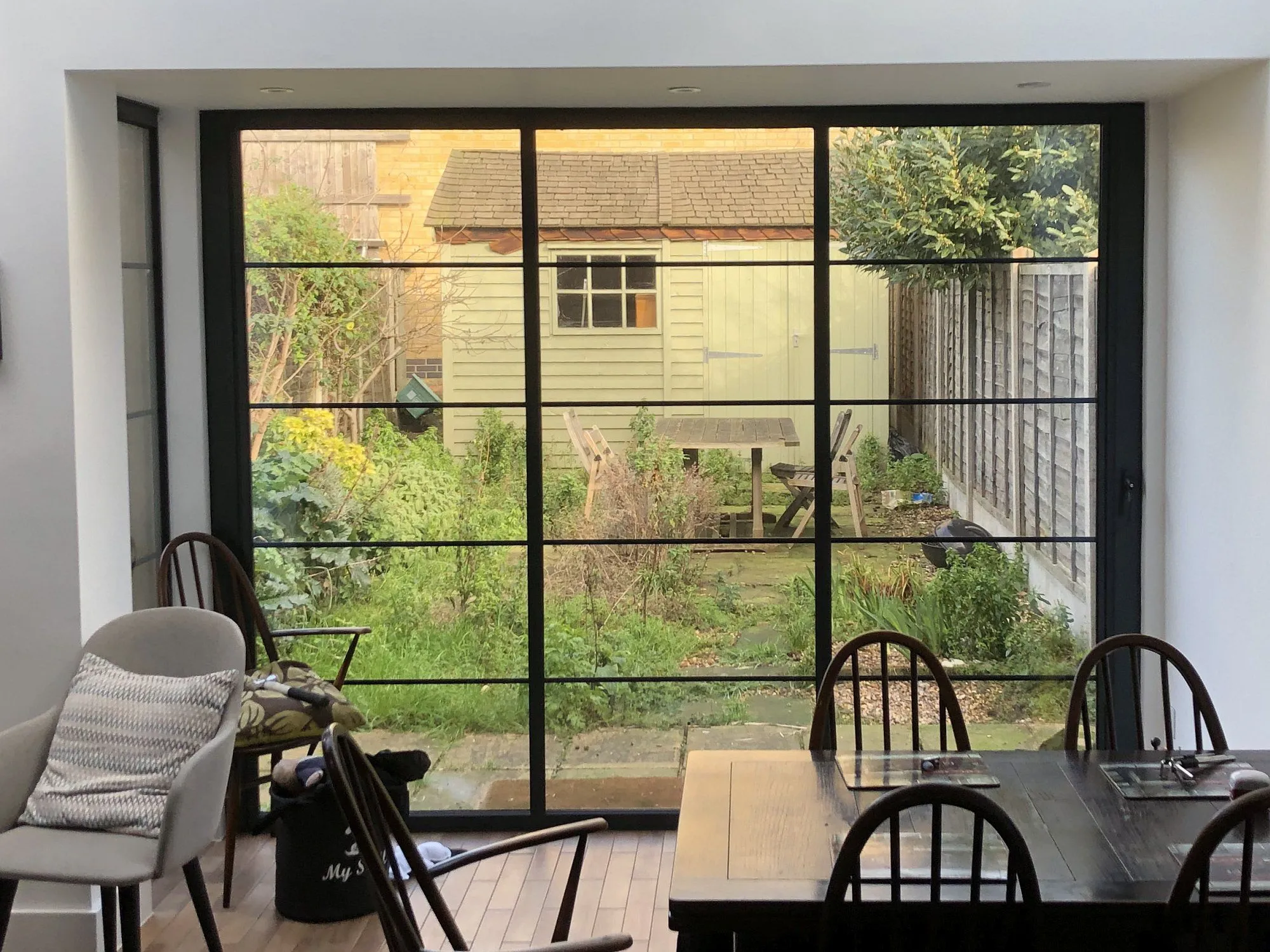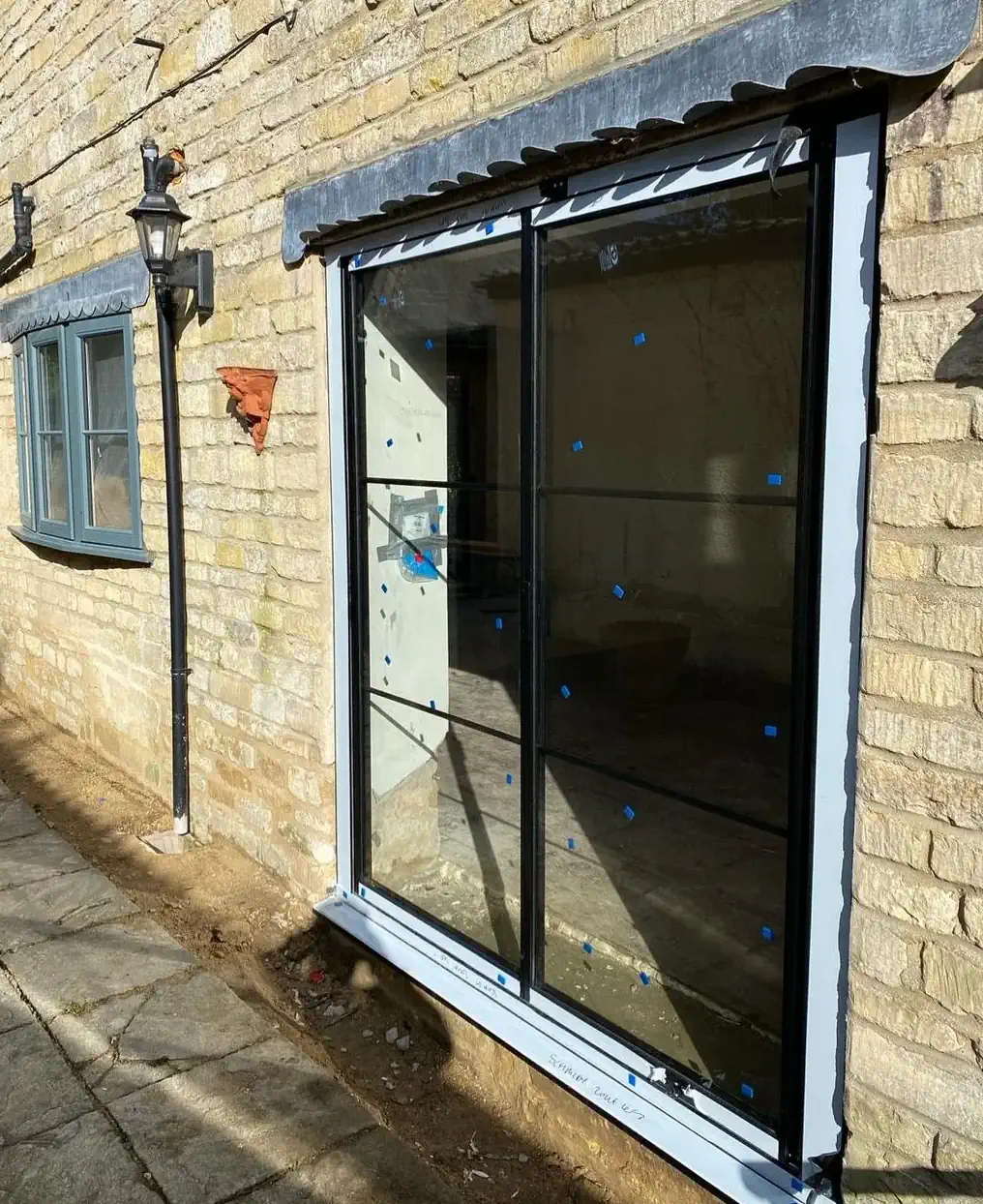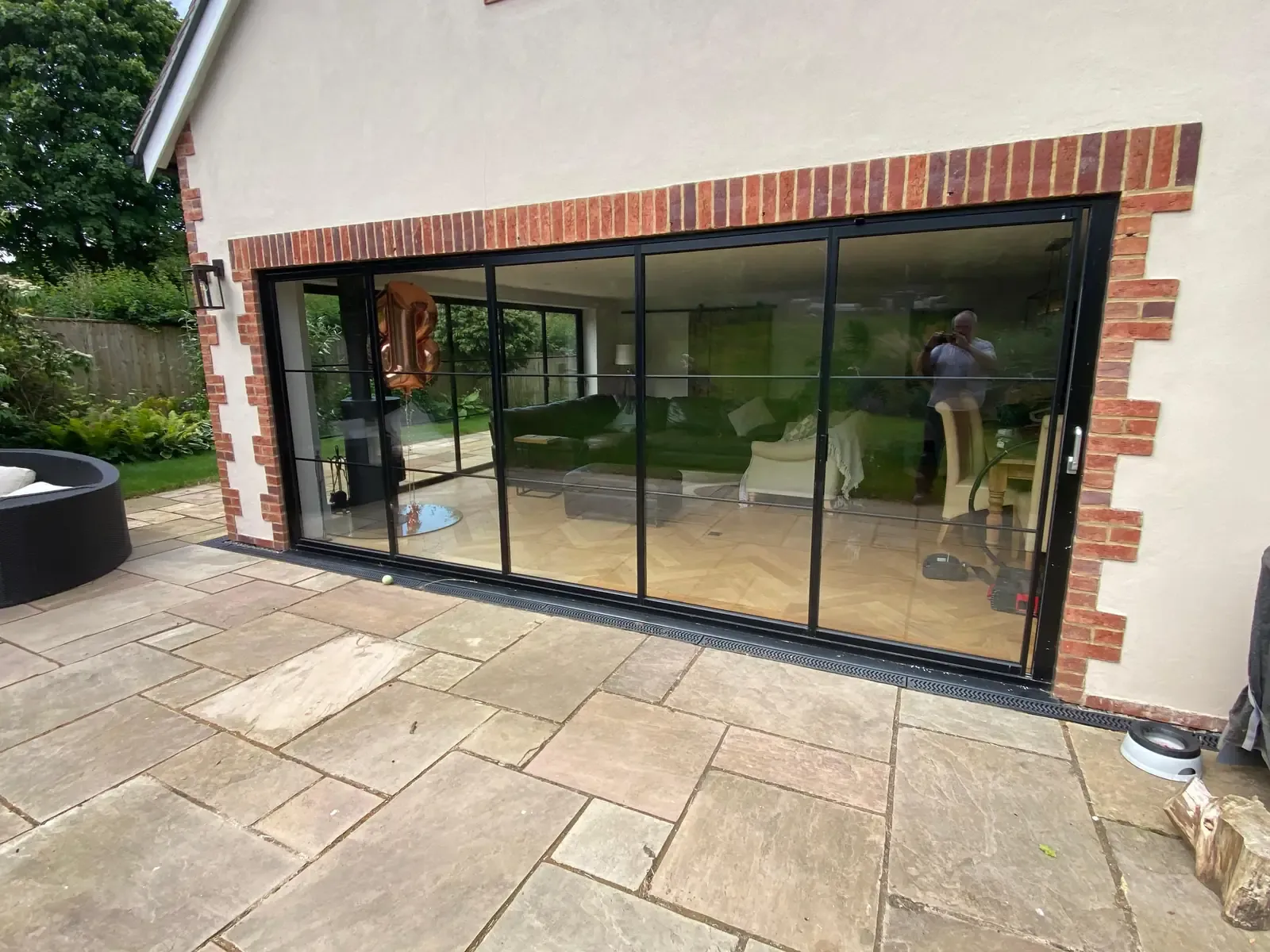A Guide to Modern Heritage Patio Doors
Table of Contents

Heritage Patio Door Styles
Heritage patio doors pay homage to architectural traditions while meeting today’s performance standards. From Georgian elegance to Art Deco boldness, various styles cater to different period properties.

Georgian-Inspired Patio Doors
Georgian architecture, known for its symmetry and proportion, influences many heritage patio door designs. Tall, multi-paned windows characterise this style, typically featuring a 6-over-6 or 8-over-8 grid pattern. Modern Georgian-inspired patio doors often incorporate these distinctive elements.
Astragal bars, which sit on the glass surface, recreate the look of individual panes without compromising thermal efficiency. Some manufacturers offer slim frame aluminium heritage doors that mimic the delicate wooden frames of the 18th century. These doors maintain the Georgian aesthetic while providing superior weather resistance and low maintenance.
Victorian-Style Patio Doors
Victorian-era architecture embraced ornate details and gothic influences. Heritage sliding patio doors from this period often feature intricate glasswork and decorative mouldings. Stained glass panels, popular in Victorian homes, can be incorporated into modern designs for an authentic touch.
Bay windows, a hallmark of Victorian architecture, inspire some patio door configurations. Three-panel sliding doors can create a similar effect, allowing light to flood the room from multiple angles. For a truly period-appropriate look, some homeowners opt for heritage external doors with arched tops, echoing the gothic revival style popular in Victorian Britain.
Edwardian Patio Door Designs
Edwardian architecture marked a return to simplicity after the ornate Victorian era. Patio doors inspired by this period often feature larger glass panes and less ornate detailing. Clean lines and subtle elegance characterise these designs.
Many Edwardian-style heritage sliding doors incorporate a mix of materials. Wood and metal combinations were common in the early 20th century, and modern manufacturers replicate this look with durable aluminium frames and wood-effect finishes. These doors offer the warmth of timber without the associated maintenance.
Art Deco Patio Doors
Art Deco, with its bold geometric patterns and luxurious materials, offers a distinct aesthetic for heritage patio doors. Designs inspired by this era often feature strong horizontal lines and stylised motifs. Some manufacturers offer heritage sliding patio doors with frosted glass panels etched with Art Deco-inspired patterns.
Customisation Options
Many suppliers offer bespoke options for heritage patio doors. This allows homeowners to tailor the design to their specific property, ensuring a perfect match with existing architectural features. From custom colours to unique glazing patterns, these doors can be crafted to suit individual tastes while maintaining historical accuracy.
Colour Options for Heritage Patio Doors
Selecting the right colour for heritage patio doors can make a substantial difference in how well they complement a period property. The choice of hue affects both the exterior appearance and the interior ambiance. Modern manufacturing techniques offer a wide range of options, from traditional shades to contemporary tones.
Period-Appropriate Colour Choices
When choosing colours for heritage patio doors, it’s wise to consider the architectural era of your home. Georgian properties often feature subdued, earthy tones like sage green, warm grey, or deep blue. These colours work well with the symmetrical designs typical of Georgian-inspired patio doors.
Victorian homes, known for their bold colour schemes, allow for more adventurous choices. Deep reds, rich purples, or forest greens can suit Victorian-style heritage sliding doors. These darker shades contrast beautifully with the ornate glasswork often found in Victorian designs.
Edwardian properties typically favour lighter, airier colours. Cream, light green, or soft blue can be excellent choices for Edwardian-inspired heritage external doors. These gentle hues reflect the era’s preference for brighter, more open spaces.
Dual Colour Heritage Patio Doors
Dual colour options offer flexibility in heritage door design. This approach allows for different colours on the interior and exterior faces of the door. For example, you might choose a traditional colour for the outside to match your home’s exterior, while opting for a more modern shade inside to suit your interior design.
Aluminium heritage patio doors are particularly well-suited to dual colour finishes. The powder-coating process used on aluminium allows for precise colour matching and excellent durability. This means you can have heritage sliding patio doors that look authentic from the street but coordinate perfectly with your indoor colour scheme.

Finish Options and Durability
The finish of your heritage patio doors is just as important as the colour. Different finishes can affect how the colour appears and how well it stands up to the elements. Matte finishes often work well for heritage doors, providing a subtle, understated look that suits many period properties.
For coastal areas or locations with harsh weather conditions, consider heritage doors with a textured finish. These finishes can help hide small scratches and are often more resistant to fading. Some manufacturers offer specialised coatings that mimic the look of traditional materials like wood while providing the durability of modern finishes.
When selecting a finish for aluminium heritage doors, it’s worth considering how it will age. Some finishes develop a patina over time, which can add character to heritage patio doors. Others maintain their original appearance for many years, requiring minimal maintenance to keep them looking fresh.
Integral Bars in Heritage Patio Doors
Integral bars play a key role in the aesthetic of heritage patio doors, replicating the look of traditional multi-paned windows. These bars add character and period authenticity to modern doors, helping them fit readily into older properties.
Astragal Bars
Astragal bars are a popular choice for heritage sliding patio doors, providing a convincing illusion of separate glass panes. These bars are applied to the surface of the glass, creating depth and shadow that mimics the appearance of true divided lights. The three-dimensional effect of astragal bars adds visual interest to heritage patio doors, making them a focal point in any room.
In aluminium heritage doors, astragal bars can be colour-matched to the frame for a cohesive look. Some manufacturers offer bars in contrasting colours, allowing for creative design options that can highlight the door’s geometry. Astragal bars are typically made from the same durable materials as the door frame, ensuring they withstand the test of time.

Georgian Bars
Georgian bars offer a low-maintenance alternative for heritage external doors. These bars sit between the panes of double or triple-glazed units, creating the appearance of divided lights without compromising on energy efficiency. The result is heritage patio doors that combine historical aesthetics with modern performance.
One advantage of Georgian bars is their ease of cleaning. With no surface-mounted elements, these heritage doors can be wiped down quickly and easily. Georgian bars are available in various widths and configurations, allowing homeowners to choose a design that best suits their property’s era and style.
Many manufacturers offer customisation options for integral bars in heritage patio doors. This allows homeowners to tailor the look of their doors to match existing windows or architectural features. Whether opting for astragal bars or Georgian bars, the key is to choose a design that complements the overall style of the property while meeting practical needs for light, view, and maintenance.
Heritage Patio Doors in Different Rooms
The application of heritage patio doors varies depending on the room and its purpose. These doors can add character and light to different spaces while maintaining historical authenticity.
Heritage Patio Doors for Kitchen Extensions
Kitchen extensions often present a challenge: how to connect a modern addition to a period property. Heritage patio doors can provide an elegant solution, bridging the gap between old and new. By choosing doors that echo the style of the original house, homeowners can create a cohesive look that respects the building’s history.
In kitchen extensions, aluminium heritage doors offer practical advantages. Their slim profiles allow for larger glass areas, bringing more natural light into the space. This can make the kitchen feel more spacious and airy. Heritage sliding patio doors are particularly useful in kitchens, as they don’t require swing space, allowing for more flexible layout options.

Heritage Doors in Living Rooms
Living rooms benefit greatly from the addition of heritage patio doors too. In period properties, heritage external doors help maintain the room’s character while improving access to outdoor areas.
The choice of heritage patio door style can dramatically affect the ambiance of a living room. Georgian-inspired designs with multiple panes can create a sense of grandeur, while simpler Edwardian styles might suit a more understated decor. Some homeowners opt for heritage sliding doors in living rooms to save space and allow for larger openings.
Heritage Patio Doors for Conservatories
Conservatories present a unique opportunity to showcase heritage patio doors. These light-filled spaces often serve as a link between the main house and the garden, making the choice of doors particularly important. Heritage style sliding conservatory doors can help the conservatory feel like a natural extension of a period property.
When selecting heritage patio doors for conservatories, it’s important to consider both aesthetics and practicality. Aluminium heritage patio doors offer excellent thermal performance, helping to regulate temperature in these glass-heavy spaces. The slim profiles of these doors also allow for larger glass areas too.
Balancing Light and Privacy
In all rooms, heritage patio doors must balance the desire for light with the need for privacy. Many manufacturers offer obscured or textured glass options that maintain the period look while providing increased privacy. Some heritage sliding patio doors can be fitted with internal blinds, offering a modern solution to light control that doesn’t detract from the door’s historical appearance.
Installing Heritage Patio Doors
Conservation Area Guidelines
Properties in conservation areas often face strict regulations regarding alterations. Installing heritage patio doors in these areas requires a delicate balance between preserving historical character and improving living spaces. Local planning authorities typically have specific guidelines for heritage external doors, which may dictate materials, colours, and designs.
Energy Efficiency in Heritage Patio Doors
Improving energy efficiency is a common goal when installing new doors in older properties. Modern heritage patio doors can significantly reduce heat loss compared to original single-glazed doors. Double or triple glazing, combined with thermally broken frames, can help keep homes warmer in winter and cooler in summer.
Aluminium patio doors often excel in energy performance. The material’s strength allows for slimmer frames, which means larger glass areas and potentially more solar gain. Some manufacturers offer heritage sliding doors with low-E glass coatings and argon-filled cavities, further improving their insulating properties.
Fitting Patio Doors in Older Properties
Older properties often have uneven walls, floors, and openings, which can complicate the installation of heritage patio doors. Experienced installers can use various techniques to overcome these challenges, such as using adjustable frames or custom-made thresholds. In some cases, minor building work may be necessary to create a suitable opening for the new doors.
When fitting heritage patio doors, it’s necessary to maintain the building’s structural integrity, for obvious reasons! This might involve adding lintels or reinforcing existing ones to support the weight of new doors. For larger openings, heritage sliding patio doors can be a good option, as they distribute their weight across a wider area.
Integrating Existing Architectural Elements
Preserving original features is often a priority when installing heritage patio doors. This might involve working around existing stonework, incorporating original glazing patterns, or matching the profile of other windows in the property. Some homeowners choose to repurpose elements of original doors, such as using old door furniture on new heritage external doors.
Bespoke manufacturing allows for heritage patio doors that perfectly complement existing architectural elements. This might involve creating custom mouldings, matching specific paint colours, or replicating unique glazing patterns. While this level of customisation can increase costs, it often results in doors that look as though they’ve always been part of the property.
Heritage Patio Doors FAQ
What are heritage style doors?
Heritage style doors are designed to complement period properties or add a traditional touch to newer homes. They typically feature details such as decorative glazing bars, ornate hardware, and classic colour schemes. These doors combine historical aesthetics with modern manufacturing techniques to provide improved security and energy efficiency.
Can I install heritage patio doors in a new build property?
Absolutely. Installing heritage patio doors in modern homes can add character and a unique aesthetic appeal. Many homeowners choose heritage-style doors to create a contrast with contemporary architecture or to add a touch of timeless elegance to their new build. It’s important to consider the overall design of your home to ensure the doors complement rather than clash with the existing style.
What styles of heritage sliding patio doors are available?
Heritage sliding patio doors come in various styles inspired by different architectural periods. Common options include Georgian-style doors with symmetrical panes, Victorian-inspired designs with ornate details, and Edwardian-influenced doors featuring simpler, elegant lines. Some manufacturers also offer Art Deco-inspired sliding doors with bold geometric patterns. Heritage options are available for many of the most popular types of patio doors, such as bifold patio doors, sliding patio doors, and slide and stack patio doors.
How do I choose the right colour for my heritage external doors?
When selecting colours for heritage external doors, consider the architectural style of your home and the surrounding environment. Anthracite grey is a popular modern choice that complements many period properties, while black patio doors offer a classic, timeless look. For a more traditional appearance, consider deep greens, rich reds, or warm browns that were commonly used in historical contexts.
What's the best material for heritage patio door frames?
Aluminium is often considered the best option for heritage-style designs. Aluminium offers excellent durability, low maintenance, and slim profiles that can closely mimic traditional timber frames. This material also allows for larger glass areas, improving natural light and views while maintaining the authentic look of heritage doors.
What are Crittall style doors?
Sliding Crittall doors are inspired by the iconic steel-framed windows popularised in the early 20th century. These doors feature slim, dark-coloured frames divided into a grid pattern, creating a distinctive industrial aesthetic. Modern Crittall-style doors often use aluminium to provide better thermal performance and corrosion resistance while maintaining the classic look.
What are the benefits of slimline sliding doors?
Slimline patio doors offer several advantages, including a higher glass area for better views and increased natural light. Their slim profiles can closely replicate the appearance of traditional steel-framed doors, making them suitable for heritage properties. Slimline doors also tend to be more energy-efficient and easier to maintain than their bulkier counterparts.
How do thermal breaks in aluminium heritage doors improve energy efficiency?
Thermal breaks in aluminium heritage doors create a barrier between the interior and exterior parts of the frame, reducing heat transfer. This design feature hugely improves the door’s insulation properties, helping to maintain a comfortable indoor temperature and reduce energy costs. Thermal breaks also help prevent condensation, which can be a common issue in older, less efficient door designs.
What security features are available for heritage patio doors?
Heritage patio doors can be equipped with various security features, including multi-point locking systems that secure the door at multiple points along the frame. Other options include toughened or laminated safety glass, anti-lift mechanisms for sliding doors, and high-security cylinders. Some manufacturers also offer smart locks that can be integrated with home security systems for added protection.
We’d Love to Help You
Vision Glass Doors is a designer, manufacturer, and installer of premium door systems. We are a family run business with over 20 years’ experience and 5,000 installations across the UK.
Our leading range of door systems include Ultra Slim – Slide and Turn Doors, Slimline Sliding Patio Doors and Frameless Glass Doors. Suitable for various internal and external applications, they are applicable to residential and commercial projects.
Click Quick Quote Online for a free quotation within 24 hours. Alternatively, call or email us on 01582 492730 or at info@visionglassdoors.co.uk.

